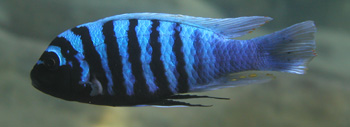
 |
Carleton lab research |
||||
| Research | People | Publications | Protocols | Links | |
African cichlid fishes are well known for their rapid rates of speciation and diversification. Breeding males display bright coloration to attract potential mates. Studies have shown that visual cues are sufficient for cichlids to correctly choose conspecifics for mating or male aggression. Because of the importance of visual communication, we are working to understand the sensitivities of the cichlid visual system. In addition, we want to learn how diverse the cichlid visual system is and how it differs between species, genera and between lakes.
Vision starts in the photoreceptors in the retina. These cells contain visual pigments which absorb light of different wavelengths. This absorption is determined by the opsin protein surrounding the retinal chromophore. We have been working to characterize the opsin genes and the cone visual sensitivities in a variety of cichlid fishes. Some of our findings are described below:
1a. Genetic basis for cichlid visual sensitivities
Opsin genes
We have found seven cichlid cone opsin genes. These include SWS1, SWS2A, SWS2B, RH2A&alpha, RH2A&beta, RH2B, and LWS. Further, we have found that the genes are clustered in th genome. SWS2A - SWS2B - LWS are contained within 15 kb, while RH2A&alpha - RH2A&beta - RH2B are within a 20 kb stretch. Phylogenetic analysis suggests that the SWS2A-SWS2B and RH2A-B duplications occurred almost 200 MY ago. These genes are likely to occur in a broad array of fishes (Parry et al 2005, Spady et al 2006). The RH2A&alpha-RH2A&beta duplication is fairly recent and likely specific to cichlids.

Differences in developmental gene expression patterns
We have quantified developmental changes in opsin gene expression. We find that in the riverine ancestor, the tilapia Oreochromis niloticus, there is a progression of gene expression, from a juvenile short wavelength shifted gene set to a long wavelength shifted set in the adults. All seven cone opsin genes are expressed at some developmental stage in this species (shown at left). In contrast, developmental comparisons in the Lake Malawi and Victoria species suggests that the lake species seem to express only one set of opsin genes throughout life (Carleton et al 2005, Spady et al 2006, Carleton et al 2008). These differences are the result of heterochrony, changes in the developmental progression of opsin gene expression.Differences in gene expression patterns between species
We have shown that Lake Malawi cichlids express only 3 or 4 cone opsin genes at a time and species differ in the set of genes expressed. This produces large differences in visual sensitivity and is one of the first examples of species, which tune visual sensitivity by turning opsin genes on and off. Some species have sensitivities similar to humans. Others have shifted their visual sensitivities to much shorter wavelength and are sensitive in the ultraviolet wavelength region. So far, we have identified three different combinations of cone opsin genes in various species within this lake. Here we show the relative gene expression for the sand dweller Dimidiochromis compressiceps and the rock dweller Metriaclima zebra. D. compressiceps expresses the SWS2A, RH2A and LWS genes, while M. zebra expresses the SWS1, RH2B and RH2A genes (Carleton et al 2008). In these results the expression of RH2A&alpha and RH2A&beta genes are combined as RH2A.Can differences in visual sensitivity drive speciation?
To determine whether visual sensitivities differ between sister taxa, we have examined four species in the genus Pundamilia, which differ in male color (red vs. blue). Working with Ole Seehausen and Jim Bowmaker, we found that these species have similar visual sensitivities, based on microspectrophotometry, opsin gene sequence, and gene expression. However, there are slight differences in the long wavelength visual pigment and LWS opsin sequence, which are correlated with male color and could have an effect on differential mate choice. (Carleton et al 2005). More recent data suggests that these differences drive speciation (Seehausen et al 2008).1b. Protein expression and in situ measurements of visual sensitivity
Functional characterization of opsin genes
The spectral properties of the photoreceptor cells are determined by the absorption characteristics of the visual pigments unique to each cell type. Working with Jim Bowmaker, David Hunt, and Phyllis Robinson, we have expressed the proteins, which correspond to these pigments. This provides a precise link between genotype and phenotype. We have shown that the seven cone opsin genes produce unique pigments and are separated by 10-60 nm relative to the next closest gene (Spady et al 2006).We have confirmed protein expression in situ by quantifying the visual pigment absorption properties with microspectrophotometry (MSP). We have examined different developmental stages in tilapia, working with Ellis Loew and Bill MacFarland (Carleton et al 2008). We do indeed find differences in protein expression through the life stages as the gene expression results predict. In Lake Malawi, species which differ in gene expression, also differ in the visual pigment absorptions present in the cones (Carleton and Kocher 2001, Parry et al. 2005).